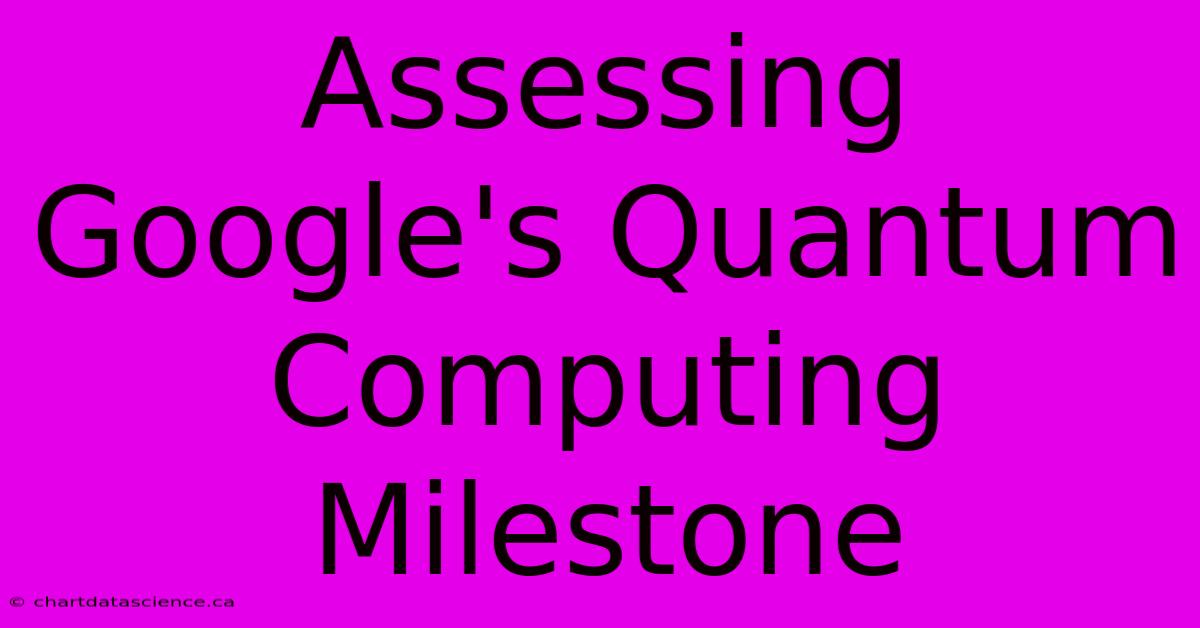Assessing Google's Quantum Computing Milestone

Discover more detailed and exciting information on our website. Click the link below to start your adventure: Visit My Website. Don't miss out!
Table of Contents
Assessing Google's Quantum Computing Milestone: A Leap Forward or Hype?
Google's claim of achieving "quantum supremacy" – a computer performing a calculation beyond the capabilities of even the most powerful classical supercomputers – sparked a wave of excitement and skepticism within the scientific community. While the achievement is undeniably significant, a nuanced assessment is crucial to understanding its true implications and avoiding inflated expectations. This article delves into the details of Google's milestone, analyzing its impact and future prospects.
What Google Achieved
Google's breakthrough involved their Sycamore quantum processor performing a specific, albeit complex, calculation in approximately 200 seconds. Classical supercomputers, according to their research, would require approximately 10,000 years to complete the same task. This significant speed difference is the core of their "quantum supremacy" claim. The calculation itself isn't practically useful; it's a benchmark designed to demonstrate the potential of quantum computing.
The Significance of the Sycamore Processor
The Sycamore processor is a superconducting quantum computer utilizing a specific type of qubit. The sheer number of qubits and the relatively low error rate achieved are crucial aspects of this success. While the number of qubits involved is still relatively small compared to the scale needed for practical applications, it represents a significant leap in quantum computing hardware development.
Skepticism and Counterarguments
Despite the impressive claims, Google's announcement faced immediate criticism. IBM, a major competitor in the quantum computing field, argued that a classical supercomputer, with optimized algorithms and sufficient memory, could complete the same task in a much shorter timeframe – perhaps days, not thousands of years. This highlights a key challenge in verifying quantum supremacy claims: the difficulty of accurately assessing the capabilities of classical computers on such complex tasks.
The Limitations of the Current Achievement
It's crucial to emphasize that Google's milestone doesn't signal the immediate arrival of practical quantum computers capable of solving real-world problems. The calculation performed was highly specialized and not applicable to broader computing needs. Furthermore, the current quantum computers, including Google's Sycamore, are highly susceptible to errors, limiting their scalability and reliability for complex applications.
The Path Ahead: Challenges and Opportunities
The road to building truly practical and fault-tolerant quantum computers is still long and challenging. Several hurdles remain, including:
- Qubit Scalability: Increasing the number of stable, reliable qubits is essential for tackling more complex problems.
- Error Correction: Developing robust error correction techniques is crucial to mitigate the inherent instability of qubits.
- Algorithm Development: Creating quantum algorithms optimized for specific problems is an ongoing area of research.
- Hardware Advancement: Further improvements in quantum computer hardware design and manufacturing are necessary.
The Broader Impact of Google's Work
Despite the limitations, Google's work is undeniably important. It represents a significant step forward in the development of quantum computing technology, pushing the boundaries of what's possible and stimulating further research and development in the field. It serves as a strong validation of the potential of quantum computing and encourages further investment in this rapidly evolving area.
Conclusion: A Promising Milestone, Not a Revolution
Google's achievement should be viewed as a significant milestone on the long path towards practical quantum computing, not as a revolutionary breakthrough that immediately alters our technological landscape. While skepticism is healthy and necessary, the progress made should not be underestimated. The future of quantum computing remains bright, with ongoing advancements promising powerful applications across various fields, including medicine, materials science, and artificial intelligence. The journey is far from over, but Google’s work has undoubtedly provided a powerful impetus for further exploration and innovation.

Thank you for visiting our website wich cover about Assessing Google's Quantum Computing Milestone. We hope the information provided has been useful to you. Feel free to contact us if you have any questions or need further assistance. See you next time and dont miss to bookmark.
Also read the following articles
| Article Title | Date |
|---|---|
| Jury Clears Daniel Penny In Death Case | Dec 10, 2024 |
| Third No Confidence Vote Imminent | Dec 10, 2024 |
| Bo C Expected To Lower Rates Again | Dec 10, 2024 |
| Red Wings Edge Sabres In Shootout Win | Dec 10, 2024 |
| United Healthcare Ceo Mangione Charged | Dec 10, 2024 |
